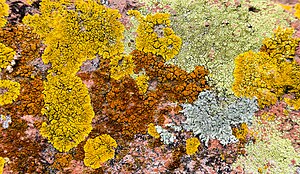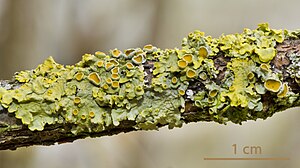Wikipedia:WikiProject Fungi/Lichen task force/Recognized content
Appearance
| Main page | Talk | Article alerts | Assessment | Article template | Showcase | Resources | Popular pages | Newsletters | Collaboration | To do |
| This is a list of recognized content, updated weekly by JL-Bot (talk · contribs) (typically on Saturdays). There is no need to edit the list yourself. If an article is missing from the list, make sure it is tagged or categorized (e.g. Category:Lichen task force articles) correctly and wait for the next update. See WP:RECOG for configuration options. |
Featured articles
[edit]Featured lists
[edit]Good articles
[edit] Allocalicium
Allocalicium Ove Almborn
Ove Almborn Anaptychia ciliaris
Anaptychia ciliaris Brodoa oroarctica
Brodoa oroarctica Buellia frigida
Buellia frigida Caliciaceae
Caliciaceae Cetrelia
Cetrelia Chrysothrix chlorina
Chrysothrix chlorina Cladoniaceae
Cladoniaceae Confluentic acid
Confluentic acid Cryptothecia rubrocincta
Cryptothecia rubrocincta Gunnar Degelius
Gunnar Degelius Gustaf Einar Du Rietz
Gustaf Einar Du Rietz Enchylium conglomeratum
Enchylium conglomeratum Siegfried Huneck
Siegfried Huneck Hydropunctaria amphibia
Hydropunctaria amphibia Isolichenan
Isolichenan Lecideaceae
Lecideaceae Lepraria incana
Lepraria incana Lichen growth forms
Lichen growth forms Lichexanthone
Lichexanthone Linnaean Herbarium
Linnaean Herbarium Lobaria pulmonaria
Lobaria pulmonaria Elke Mackenzie
Elke Mackenzie Melanohalea
Melanohalea Melanohalea exasperatula
Melanohalea exasperatula Konstantin Mereschkowski
Konstantin Mereschkowski Multiclavula mucida
Multiclavula mucida Thomas Hawkes Nash III
Thomas Hawkes Nash III Normandina pulchella
Normandina pulchella Parmelia barrenoae
Parmelia barrenoae Parmelia sulcata
Parmelia sulcata Parmotrema perlatum
Parmotrema perlatum Peltigera castanea
Peltigera castanea Peltigera cinnamomea
Peltigera cinnamomea Phacopsis
Phacopsis Physcia caesia
Physcia caesia Pilophorus acicularis
Pilophorus acicularis Placidium arboreum
Placidium arboreum Pulchrocladia retipora
Pulchrocladia retipora Punctelia
Punctelia Punctelia borreri
Punctelia borreri Punctelia graminicola
Punctelia graminicola Punctelia hypoleucites
Punctelia hypoleucites Punctelia rudecta
Punctelia rudecta Ramalina peruviana
Ramalina peruviana Roccellaceae
Roccellaceae Ludwig Schaerer
Ludwig Schaerer Solorina crocea
Solorina crocea Spot test (lichen)
Spot test (lichen) Emmanuël Sérusiaux
Emmanuël Sérusiaux Tuckermannopsis ciliaris
Tuckermannopsis ciliaris Umbilicaria torrefacta
Umbilicaria torrefacta Verrucariaceae
Verrucariaceae Antonín Vězda
Antonín Vězda Xylopsora canopeorum
Xylopsora canopeorum
Good article nominees
[edit]Featured pictures
[edit]-
Haeckel Lichenes
-
Xanthoria elegans 97571 wb1
Did you know? articles
[edit] ... that the lichen species Acarospora janae was named after its discoverer's fiancée?
... that the lichen species Acarospora janae was named after its discoverer's fiancée? ... that while most lichens that grow on plants live on the surface, the sole species in Amazonotrema grows partially among the cells of the tree bark on which it lives?
... that while most lichens that grow on plants live on the surface, the sole species in Amazonotrema grows partially among the cells of the tree bark on which it lives? ... that species in the fungal genus Ameliella have been found in the Skibotn area in central Northern Norway, a hotspot of lichen species diversity?
... that species in the fungal genus Ameliella have been found in the Skibotn area in central Northern Norway, a hotspot of lichen species diversity? ... that the German lichenologist and taxonomist Ferdinand Christian Gustav Arnold had a personal herbarium of 150,000 specimens?
... that the German lichenologist and taxonomist Ferdinand Christian Gustav Arnold had a personal herbarium of 150,000 specimens? ... that the Antarctic lichen Buellia frigida has been to outer space?
... that the Antarctic lichen Buellia frigida has been to outer space? ... that the Santa Rosa Island endemic lichen Caloplaca obamae is the first species to be named in honor of United States President Barack Obama?
... that the Santa Rosa Island endemic lichen Caloplaca obamae is the first species to be named in honor of United States President Barack Obama? ... that extracts of the lichen species Cladonia furcata (pictured) can kill leukemia cells?
... that extracts of the lichen species Cladonia furcata (pictured) can kill leukemia cells? ... that the Florida perforate cladonia was the first lichen to be added to the United States' endangered species list?
... that the Florida perforate cladonia was the first lichen to be added to the United States' endangered species list? ... that collections left by naturalists Frederick Lukis and his daughter Louisa, wife of Sark's feudal ruler William Thomas Collings, are the most significant natural history collections displayed by the museums of Guernsey?
... that collections left by naturalists Frederick Lukis and his daughter Louisa, wife of Sark's feudal ruler William Thomas Collings, are the most significant natural history collections displayed by the museums of Guernsey? ... that the red pigment of the Christmas wreath lichen (pictured) is one of several chemicals that help the organism survive inhospitable environments?
... that the red pigment of the Christmas wreath lichen (pictured) is one of several chemicals that help the organism survive inhospitable environments? ... that pink earth lichen was once thought to be in the same genus as the similar-looking brown beret lichen, until DNA sequencing proved otherwise?
... that pink earth lichen was once thought to be in the same genus as the similar-looking brown beret lichen, until DNA sequencing proved otherwise? ... that one species of Dictyonema lichen is a powerful hallucinogen that is traditionally used by the Huaorani of the Amazon jungle of Ecuador to cast curses on their enemies?
... that one species of Dictyonema lichen is a powerful hallucinogen that is traditionally used by the Huaorani of the Amazon jungle of Ecuador to cast curses on their enemies? ... that while the lichen species Enchylium conglomeratum is considered secure globally, it has been designated as extinct in the UK and regionally extinct in Switzerland?
... that while the lichen species Enchylium conglomeratum is considered secure globally, it has been designated as extinct in the UK and regionally extinct in Switzerland? ... that Enchylium limosum (example pictured) loves lime?
... that Enchylium limosum (example pictured) loves lime? ... that the boreal felt lichen (pictured), one of the most endangered lichens in the world, begins its life by growing inside of the liverwort Frullania asagrayana (also pictured)?
... that the boreal felt lichen (pictured), one of the most endangered lichens in the world, begins its life by growing inside of the liverwort Frullania asagrayana (also pictured)? ... that the lichen genus Felipes is named for its fruiting structures, which resemble a cat's paw?
... that the lichen genus Felipes is named for its fruiting structures, which resemble a cat's paw? ... that Gowardia, a lichen found in arctic and alpine tundra on both sides of the world, is named after the lichenologist Trevor Goward?
... that Gowardia, a lichen found in arctic and alpine tundra on both sides of the world, is named after the lichenologist Trevor Goward? ... that the uncommon Florida lichen species Gyalectidium yahriae was named after Rebecca Yahr of the Royal Botanic Garden Edinburgh in Scotland?
... that the uncommon Florida lichen species Gyalectidium yahriae was named after Rebecca Yahr of the Royal Botanic Garden Edinburgh in Scotland? ... that the yellow bloodstain lichen is not always yellow?
... that the yellow bloodstain lichen is not always yellow? ... that Tory Member of Parliament Admiral Theobald Jones (1790–1868) laid the foundation of Irish lichenology?
... that Tory Member of Parliament Admiral Theobald Jones (1790–1868) laid the foundation of Irish lichenology? ... that Matilda Cullen Knowles is considered the founder of modern studies of Irish lichens?
... that Matilda Cullen Knowles is considered the founder of modern studies of Irish lichens? ... that wolf lichen, fungal species Letharia vulpina (pictured), was used historically as a wolf poison by combining it with powdered glass and meat?
... that wolf lichen, fungal species Letharia vulpina (pictured), was used historically as a wolf poison by combining it with powdered glass and meat? ... that lichexanthone, a chemical found in some lichens, enhances human sperm motility and kills mosquito larvae?
... that lichexanthone, a chemical found in some lichens, enhances human sperm motility and kills mosquito larvae? ... that the "lung lichen", species Lobaria pulmonaria, has been used for dyeing, tanning, perfume manufacturing, and brewing?
... that the "lung lichen", species Lobaria pulmonaria, has been used for dyeing, tanning, perfume manufacturing, and brewing? ... that the Anglo-Dutch multinational Unilever has patented several antifreeze proteins produced by a species of kidney lichen, due to their ability to modify ice formation in frozen foods?
... that the Anglo-Dutch multinational Unilever has patented several antifreeze proteins produced by a species of kidney lichen, due to their ability to modify ice formation in frozen foods? ... that oakmoss is a type of lichen used extensively in modern perfumery?
... that oakmoss is a type of lichen used extensively in modern perfumery? ... that while some lichen species in the genus Piccolia have ranges which span multiple continents, others are restricted to single islands?
... that while some lichen species in the genus Piccolia have ranges which span multiple continents, others are restricted to single islands? ... that the devil's matchstick (pictured) supplies fixed nitrogen to the environment?
... that the devil's matchstick (pictured) supplies fixed nitrogen to the environment? ... that tree moss, lichen species Pseudevernia furfuracea, was used in ancient Egyptian embalming?
... that tree moss, lichen species Pseudevernia furfuracea, was used in ancient Egyptian embalming? ... that a species of specklebelly lichen is only found in old growth forests and is being threatened in Scandinavia by increased predation from snails?
... that a species of specklebelly lichen is only found in old growth forests and is being threatened in Scandinavia by increased predation from snails? ... that decades after the type specimen of the lichen Punctelia graminicola was destroyed in World War II, its original name was restored after another specimen was rescued from disposal at a dump?
... that decades after the type specimen of the lichen Punctelia graminicola was destroyed in World War II, its original name was restored after another specimen was rescued from disposal at a dump? ... that a study of lichen growth in the Canadian Rockies showed that Xanthoria elegans (pictured) expands at a rate of 0.5 mm per year for the first century before slowing down?
... that a study of lichen growth in the Canadian Rockies showed that Xanthoria elegans (pictured) expands at a rate of 0.5 mm per year for the first century before slowing down? ... that the orange chocolate chip lichen (pictured) was given its common name because of its fruitbodies that look like chocolate?
... that the orange chocolate chip lichen (pictured) was given its common name because of its fruitbodies that look like chocolate? ... that some species in the lichen genus Sticta (Sticta hypochra pictured) can be used to assess the age of forests?
... that some species in the lichen genus Sticta (Sticta hypochra pictured) can be used to assess the age of forests? ... that the nineteenth-century American botanist Edward Tuckerman liked to write his studies in Latin?
... that the nineteenth-century American botanist Edward Tuckerman liked to write his studies in Latin? ... that historically, lichens like Umbilicaria torrefacta have been used to naturally dye traditional Scottish tartans and textiles?
... that historically, lichens like Umbilicaria torrefacta have been used to naturally dye traditional Scottish tartans and textiles? ... that the string-of-sausage lichen is very sensitive to air pollution and has become locally extinct over much of its former range?
... that the string-of-sausage lichen is very sensitive to air pollution and has become locally extinct over much of its former range? ... that in Nova Scotia, the tricolored bat roosts exclusively in the dangling fronds of bony beard lichen?
... that in Nova Scotia, the tricolored bat roosts exclusively in the dangling fronds of bony beard lichen? ... that Edvard August Vainio's tools for collecting lichens in Brazil included a knife, hammer, chisel, paper, a bag, and a shotgun?
... that Edvard August Vainio's tools for collecting lichens in Brazil included a knife, hammer, chisel, paper, a bag, and a shotgun? ... that according to Swedish peasant folklore, the lichen Vulpicida (pictured), when consumed, kills foxes but not dogs or wolves?
... that according to Swedish peasant folklore, the lichen Vulpicida (pictured), when consumed, kills foxes but not dogs or wolves?





